Anomalous sea-surface temperature (SST) patterns associated with decadal climate variability (DCV) phenomena are shown here. The observed SST data used for this historical analysis were compiled from National Oceanic and Atmospheric Administration (NOAA) Extended Reconstructed Sea Surface Temperature (ERSST) Version 5.
Choose a Phenomenon to display:
The Pacific Decadal Oscillation (PDO) in its original identification (Mantua et al., 1997) is a primarily North Pacific pattern with one sign of SST anomalies in central North Pacific and opposite sign anomalies around the central North Pacific in a horseshoe pattern. This SST pattern oscillates primarily at decadal-multidecadal timescales although oscillation periods from a few months to a few years are also present. The PDO is defined as the normalized Principal Component (PC) time series of the first Empirical Orthogonal Function of the Pacific SST anomalies in the region 20°N to 65°N latitude, 125°E to 100°W longitude.
 SST anomalies (°C) associated with 1 standard deviation of PC1 of North Pacific SST anomalies from January 1900 to December 2018 derived from observations (ERSST).
SST anomalies (°C) associated with 1 standard deviation of PC1 of North Pacific SST anomalies from January 1900 to December 2018 derived from observations (ERSST).
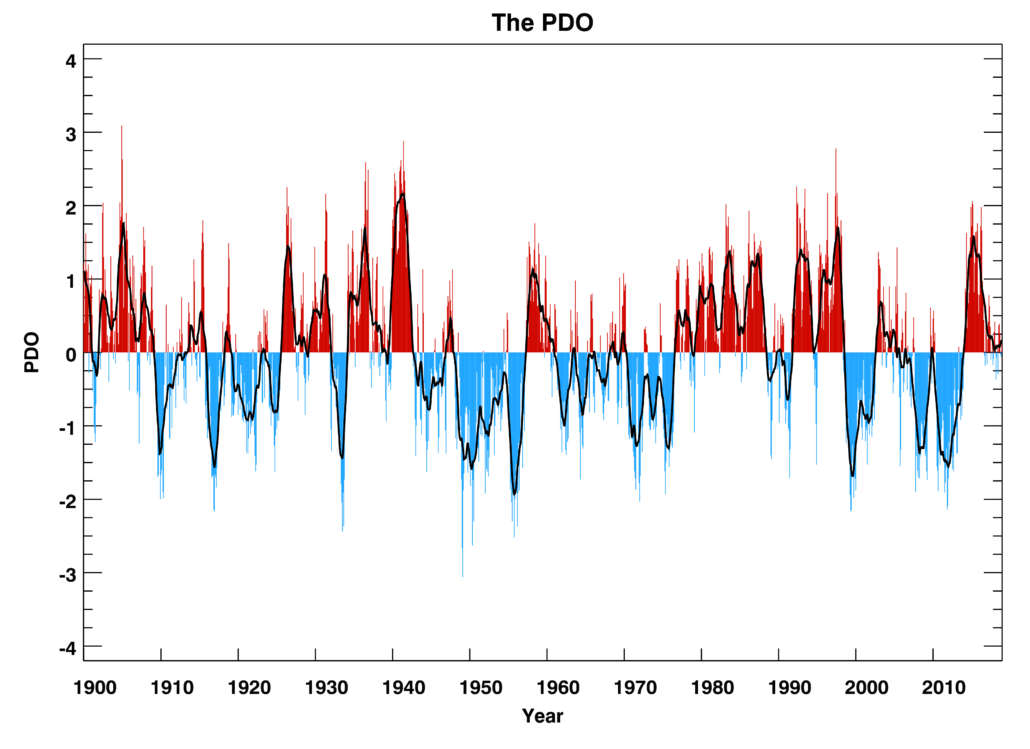 The PDO (bars) from January 1900 to December 2018 and its 12-month running-average (black line).
The PDO (bars) from January 1900 to December 2018 and its 12-month running-average (black line).
The tropical Atlantic sea-surface temperature gradient (TAG) pattern of multiyear to decadal variations has nearly constant amplitude with respect to longitude in the tropical Atlantic and opposite signs on the two sides of the equator, with the maximum amplitudes at approximately 15°N and 15°S latitude. This north–south, cross-equatorial pattern also emerges from Empirical Orthogonal Function (EOF) – Principal Component (PC) analysis of tropical Atlantic SST anomalies. The TAG index is the difference between the tropical North (5° – 20°N, 30° – 60°W) and South (0° – 20°S, 30°W – 10°E) Atlantic SST anomalies.
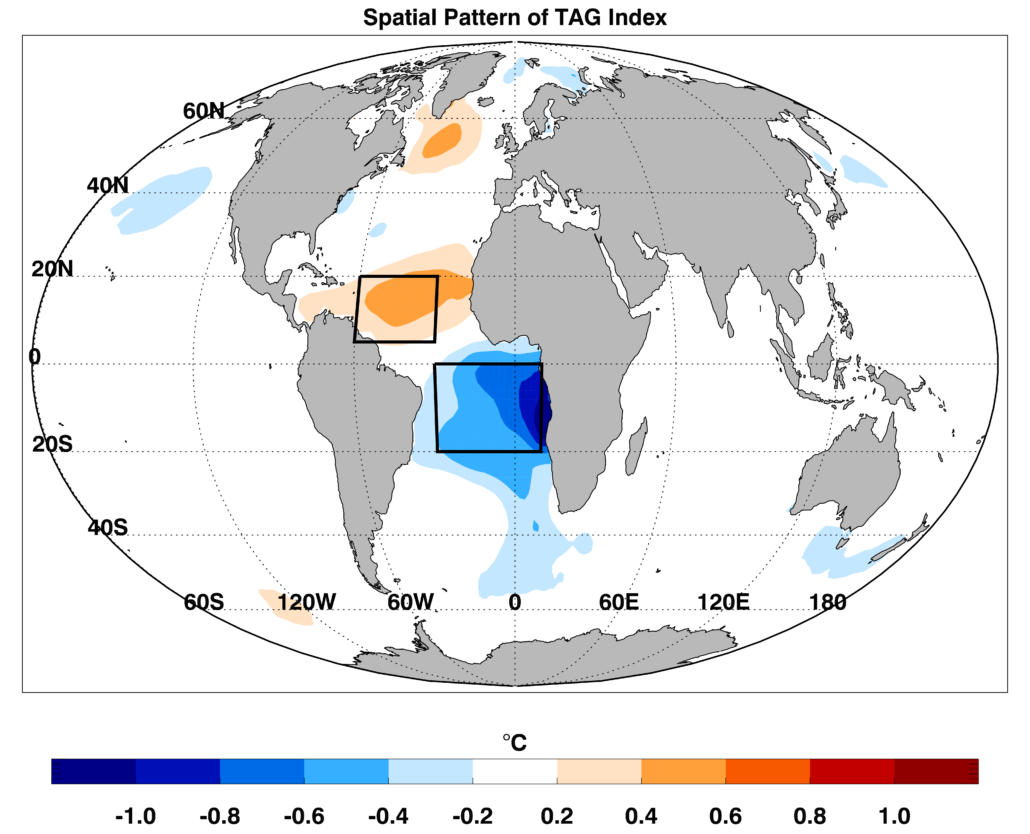 SST anomalies associated with 1°C TAG index based on linear regressions of monthly mean SST from January 1900 to December 2018.
SST anomalies associated with 1°C TAG index based on linear regressions of monthly mean SST from January 1900 to December 2018.
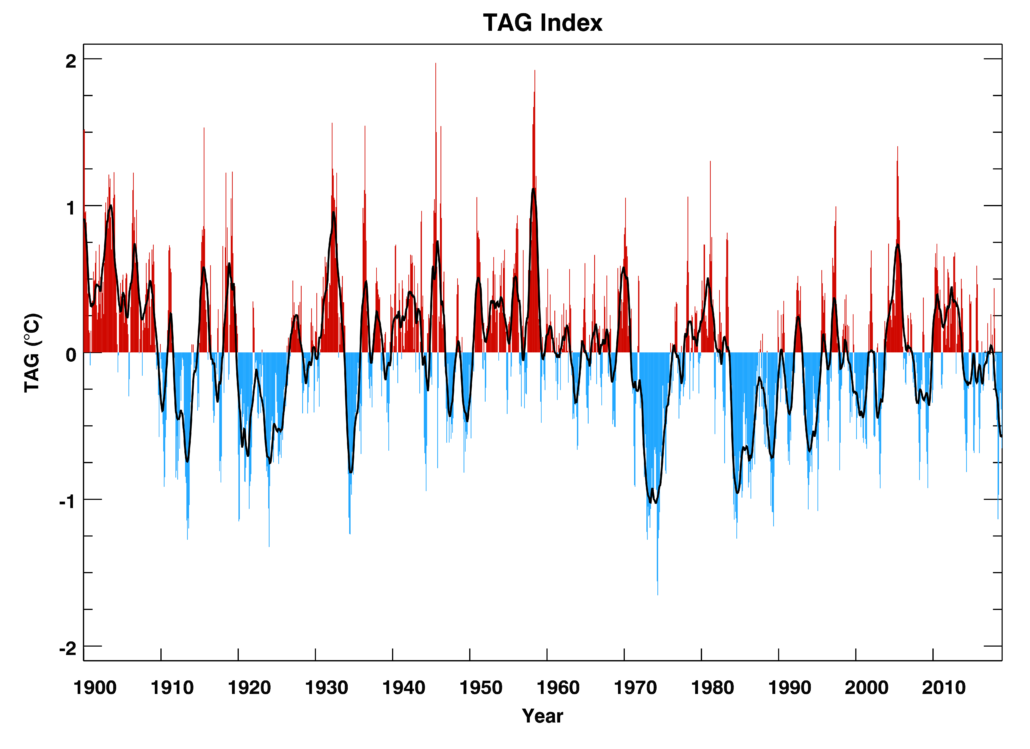 The TAG index (bars) from January 1900 to December 2018 and its 12-month running-average (black line).
The TAG index (bars) from January 1900 to December 2018 and its 12-month running-average (black line).
The West Pacific Warm Pool (WPWP) stands out in global SST maps due to its very large area of warmest temperatures. The WPWP SSTs exhibit large variations on intraseasonal, seasonal to interannual, decadal, and longer time scales. The WPWP SSTs have been warming over the 20th Century and into the 21st Century. Both the WPWP index with and without linear trend show interannual to decadal variability of the WPWP SSTs. They also show that the WPWP SST can persist in the warmer or less warm conditions for several years to a decade or longer. The WPWP index is constructed by averaging SST in 20°S – 20°N latitude, and 90°E – 180° longitude.
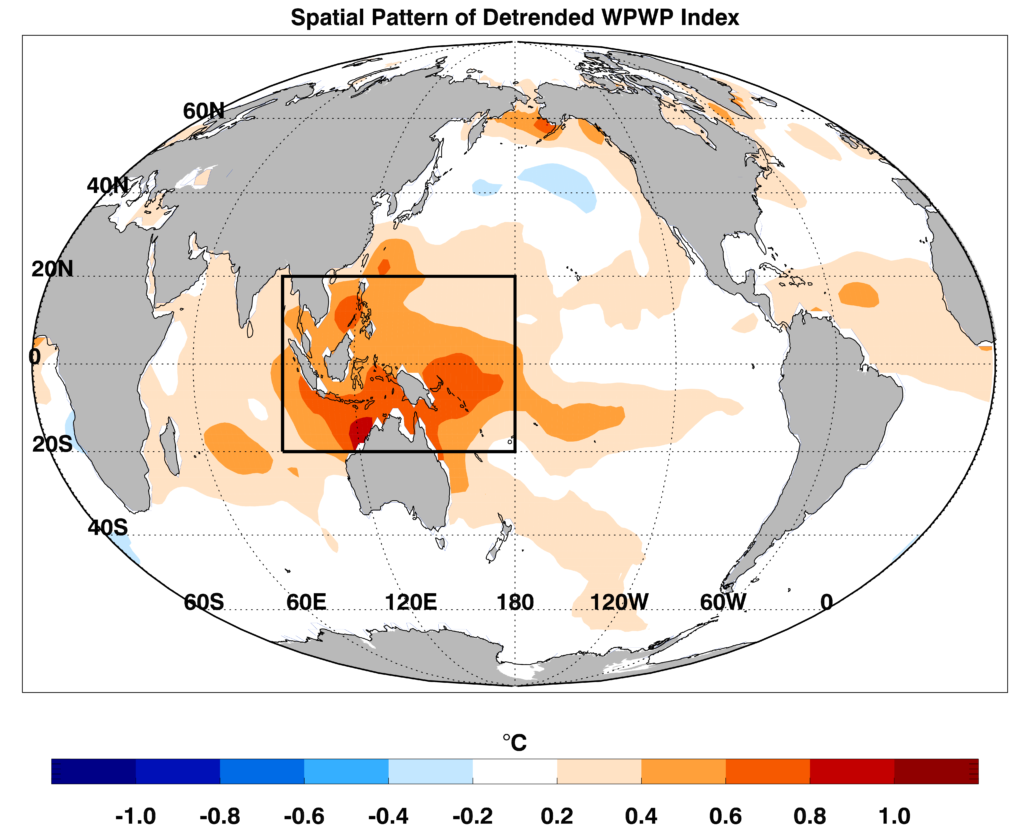 SST anomalies associated with 0.5°C WPWP index (detrended) based on linear regressions of monthly mean SST from January 1900 to December 2018.
SST anomalies associated with 0.5°C WPWP index (detrended) based on linear regressions of monthly mean SST from January 1900 to December 2018.
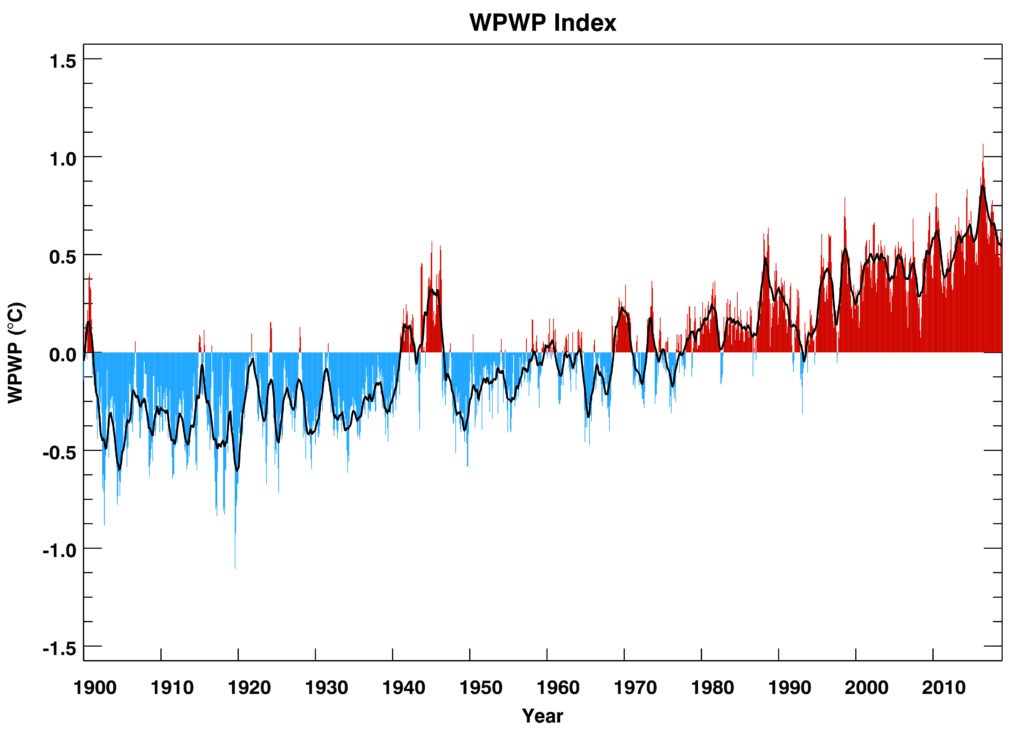 The WPWP index (°C) (bars) from January 1900 to December 2018 and its 12-month running-average (black line).
The WPWP index (°C) (bars) from January 1900 to December 2018 and its 12-month running-average (black line).
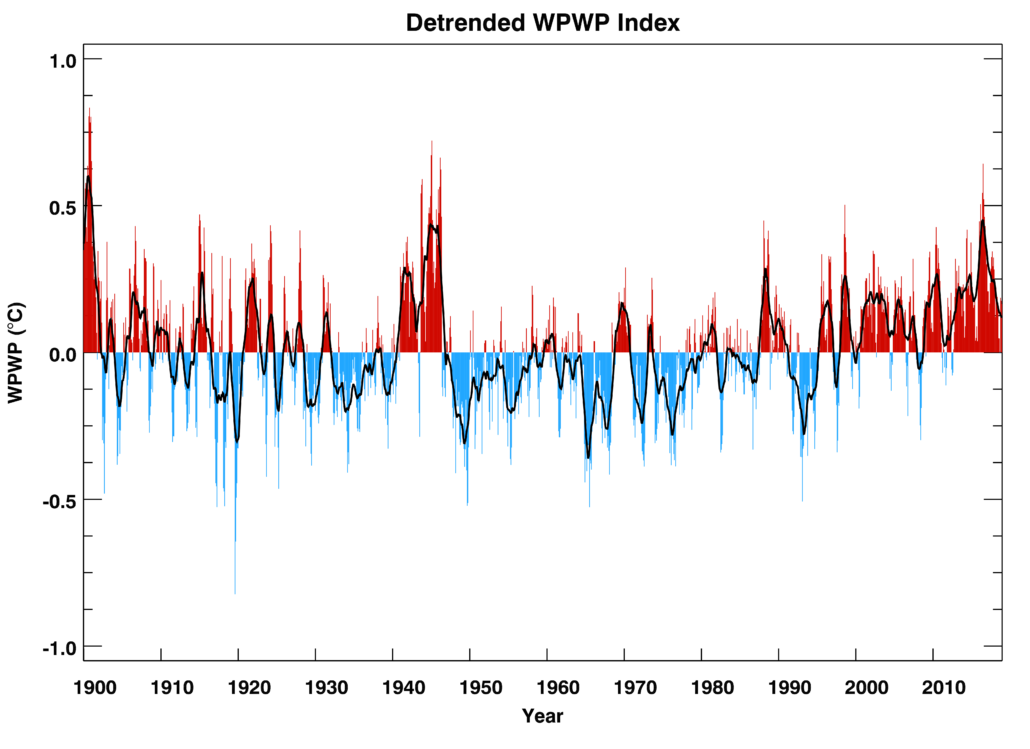 The detrended WPWP index (°C) (bars) from January 1900 to December 2018 and its 12-month running-average (black line).
The detrended WPWP index (°C) (bars) from January 1900 to December 2018 and its 12-month running-average (black line).
The East Indian Warm Pool (EIWP) stands out in global SST maps due to its very large area of warmest temperatures. The EIWP SSTs exhibit large variations on intraseasonal, seasonal to interannual, decadal, and longer time scales. The EIWP SSTs have been warming over the 20th Century and into the 21st Century. Both the EIWP index with and without linear trend show interannual to decadal variability of the EIWP SSTs. They also show that the EIWP SST can persist in the warmer or less warm conditions for several years to a decade or longer. The EIWP index is constructed by averaging SST from 20°S – 20°N latitude and 30°E – 120°E longitude.
 SST anomalies associated with 0.5°C EIWP index (detrended) based on linear regressions of monthly mean SST from January 1900 to December 2018.
SST anomalies associated with 0.5°C EIWP index (detrended) based on linear regressions of monthly mean SST from January 1900 to December 2018.
 The EIWP index (bars) from January 1900 to December 2018 and its 12-month running-average (black line).
The EIWP index (bars) from January 1900 to December 2018 and its 12-month running-average (black line).
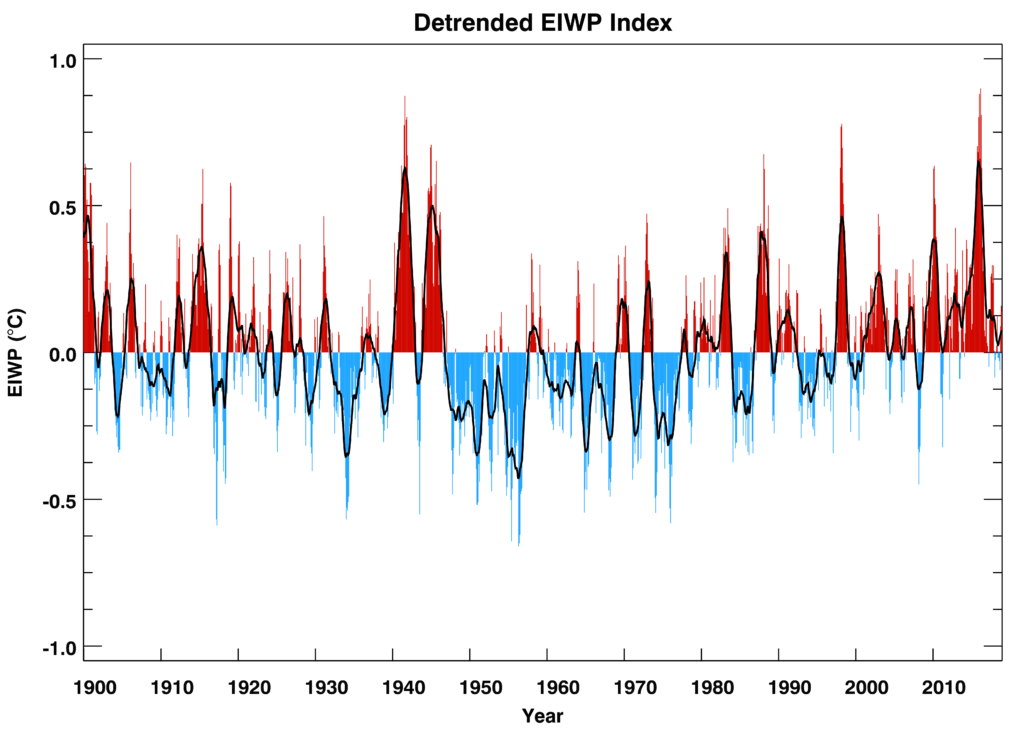 The detrended EIWP index (bars) from January 1900 to December 2018 and its 12-month running-average (black line).
The detrended EIWP index (bars) from January 1900 to December 2018 and its 12-month running-average (black line).
The Atlantic Multidecadal Oscillation (AMO) is defined as a coherent pattern of variability in North Atlantic SSTs and is formed by averaging SST anomalies from the Equator to 60°N and from 80°W to 0° as defined by Trenberth and Shea (2006). The AMO shows dominant variability at a period of 60-80 years and minor variability at a period of 10-12.
 SST anomalies associated with 0.5°C AMO based on linear regressions of monthly mean SST from January 1900 to December 2018.
SST anomalies associated with 0.5°C AMO based on linear regressions of monthly mean SST from January 1900 to December 2018.
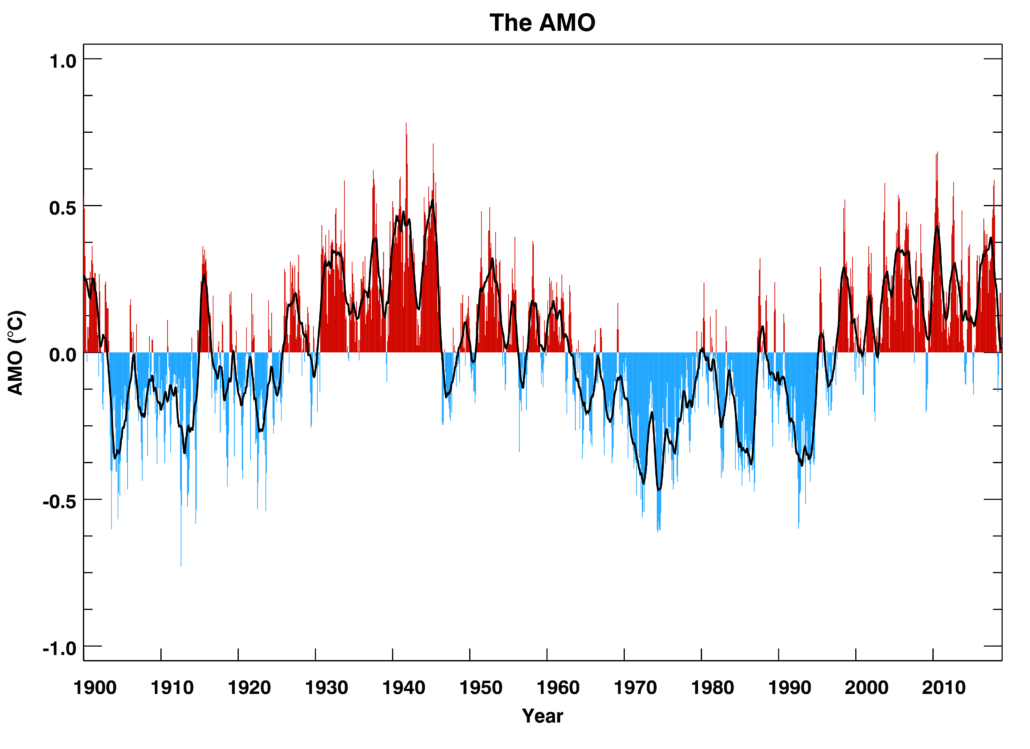 The AMO (°C) (bars) from January 1900 to December 2018 and its 12-month running-average (black line).
The AMO (°C) (bars) from January 1900 to December 2018 and its 12-month running-average (black line).
The NIÑO3.4 index is one of several El Niño-Southern Oscillation (ENSO) indicators based on sea surface temperatures. NIÑO3.4 is the average sea-surface temperature anomaly in the region bounded by 5°N to 5°S latitude and from 170°W to 120°W longitude.
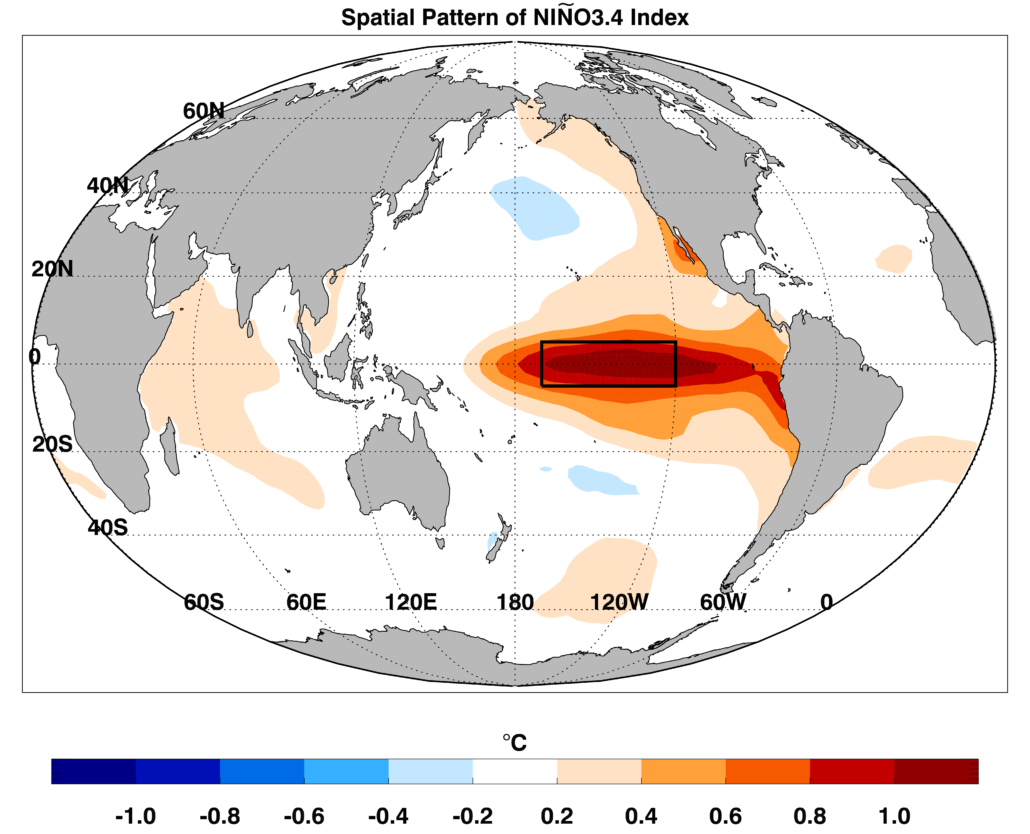 SST anomalies associated with 1°C NIÑO3.4 index based on linear regressions of monthly mean SST from January 1900 to December 2018.
SST anomalies associated with 1°C NIÑO3.4 index based on linear regressions of monthly mean SST from January 1900 to December 2018.
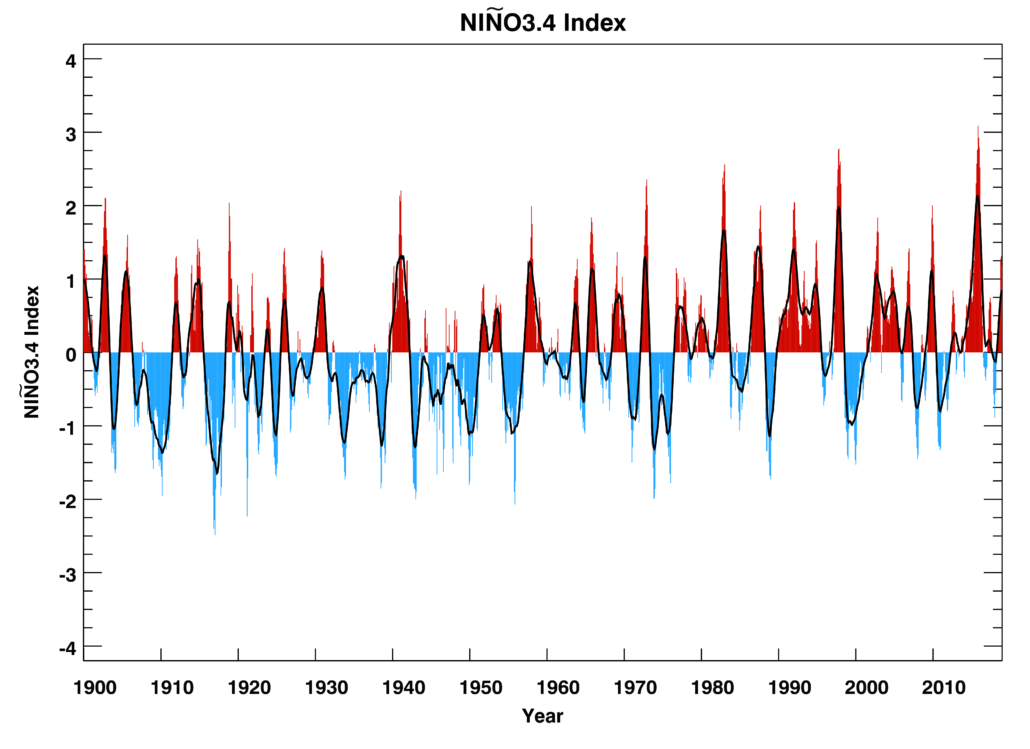 The NIÑO3.4 index (°C) (bars) from January 1900 to December 2018 and its 12-month running-average (black line).
The NIÑO3.4 index (°C) (bars) from January 1900 to December 2018 and its 12-month running-average (black line).
Major conclusions of these analyses are:
- The PDO pattern, spanning much of the Pacific and nearly symmetric in the North and South Pacific, undergoes primarily decadal-multidecadal timescale variability, with the spatial pattern persisting in positive (warm) or negative (cold) state for several years two or more decades. The PDO also varies on timescales of a few months.
- The TAG pattern undergoes variability at timescales of several seasons to a decade or longer, with the primary oscillation at the 12-13 year period. Multidecadal variations are also apparent.
- There is a pronounced warming of the WPWP and the EIWP since early 1950s. Additionally, variability at timescales of a few seasons to a few decades is also apparent.
- The AMO, spanning the Atlantic from the Equator to 60ºN, undergoes primarily multidecadal variability, with secondary decadal variability also apparent.
- The El Niño-La Niña pattern is confined largely to equatorial Pacific and undergoes variability at timescales of a few seasons to a few years.
